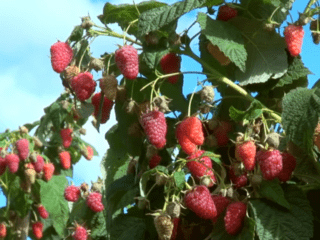Content
- 1 Features of the climate in the Urals
- 2 The best varieties of remontant raspberries for the Urals
- 3 Varieties of large-fruited raspberries for the Urals
- 4 Sweet raspberry varieties for the Urals
- 5 Early raspberry varieties for the Urals
- 6 Mid-season varieties
- 7 Late varieties
- 8 Conclusion
- 9 Reviews of raspberry varieties for the Urals
The best varieties of remontant raspberries for the Urals are represented by early and mid-season varieties. Before purchasing a plant for your site, you need to study the existing selection and characteristics of shrubs.
Features of the climate in the Urals
When choosing raspberries for the Urals, you need to focus on the climatic features of the region. Its characteristics are:
- long and cold winters with temperatures dropping to -45 °C;
- late spring, which begins no earlier than April, with returning frosts until mid-June;
- hot and often dry summers;
- early autumn with night temperatures dropping to negative values already in October.
Frost-resistant, hardy varieties with good immunity to diseases and pests are best suited for growing in the Urals. It is desirable that raspberries have strong shoots and powerful roots that penetrate deep enough into the soil.In terms of ripening time, it is worth giving preference to early and mid-ripening varieties.
The best varieties of remontant raspberries for the Urals
Remontant varieties are optimal for growing in the Urals. These raspberries begin to ripen in mid-summer and bear fruit in waves until autumn. In one season, you can reap a good harvest from several bushes.
Shelf
Mid-early ripening raspberries bear fruit from late July to early September. Produces large pink-red berries up to 5 g each. The fruits are collected in small clusters and are characterized by a pleasant sweet aroma, juiciness and bright taste. The variety is suitable for fresh consumption and for making jam.

From one Polka raspberry bush in the Urals you can harvest up to 7 kg of crop
Caramel
Remontant raspberries bear large juicy berries up to 6 g with a sweet taste. It produces up to 5 kg of fruit from one plant; you can start harvesting in the Urals in early August. The shape of the berries is wide-conical, red and shiny. After ripening, they are easily separated from the shoots, but do not fall to the ground.
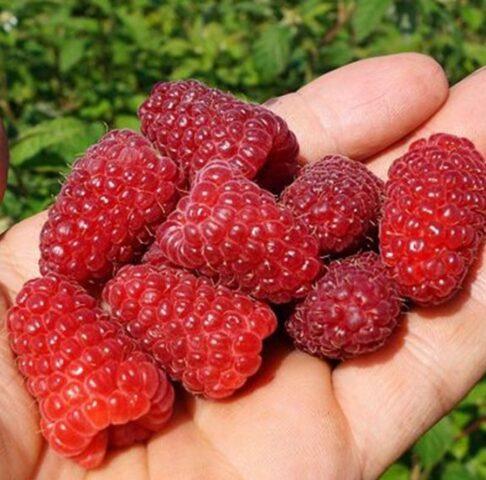
Raspberry Caramel tastes like forest
Orange miracle
Yellow-orange remontant raspberries bear medium-sized berries up to 6 g. They are compact in size and ripen smoothly; the fruits are elongated, with a rounded tip, and good density. The taste of raspberries is sweet and sour, the sugar content increases in proportion to the number of sunny days.

Raspberry Orange Miracle tolerates transportation well and does not wrinkle
Varieties of large-fruited raspberries for the Urals
Large-fruited raspberries are particularly juicy, soft and rich in taste. Several varieties are well suited for the Urals, as they are characterized not only by productivity, but also by increased frost resistance.
Penguin
The Penguin variety produces large round-conical berries with bright red-pink skin and pulp. On average, the fruits weigh 5-6 g, but can reach larger weights. The taste of raspberries is sourish-sweet; there are small seeds in the pulp, but they usually do not interfere with consumption. The variety has a long shelf life both fresh and frozen.

Raspberry Penguin in the Urals gives up to 6 kg of yield per bush
Eurasia
A hardy and frost-resistant variety is especially recommended for the Urals. It is small in size, stretches up to a maximum of 1.5 m, so the shrub is easy to cover for the winter. Raspberry fruiting begins in August, the conical berries reach a weight of about 5 g. The color of the drupes is dark red, with a matte skin, the taste is sweet and sour with a moderate aroma. The yield of Eurasia raspberries is average - an adult bush bears about 3 kg of fruit.

Raspberry Eurasia has thorns, but they are concentrated at the base of the shoots
Golden autumn
Golden-orange large-fruited raspberries with berries up to 7 g bring about 3 kg of drupes from one bush. It has a good sweet taste with a slight sourness; the variety can be grown in the Urals not only for personal use, but also for sale. The shape of the berries is conical, slightly elongated, with slight pubescence. They remain on the branches for a long time after ripening and do not fall off; when harvested they retain their density.
Fruiting of the Golden Autumn variety in the Urals begins at the end of June and lasts until late autumn. Raspberries tolerate cold weather well, but at temperatures below -30 ° C they require high-quality shelter.

Raspberry Golden Autumn grows to an average height of 1.6 m
Sweet raspberry varieties for the Urals
Raspberries with sour notes have refreshing qualities, but the sweet varieties are the most popular. They are especially suitable for fresh consumption.
Early sweet
Frost-resistant raspberries for the Urals produce dense berries of about 2 g by weight with a pronounced honey taste and rich aroma. The yield is quite good; you can get up to 4 kg of fruit from a bush.
Raspberries grow up to 2.5 m, so covering them for the winter may pose some difficulties. The advantage of the variety is the small number of offspring. There are thorns on the shoots of the bush, but there are few of them and they are quite thin.

Early sweet raspberries ripen in mid-summer
Polana
Frost-resistant raspberries begin bearing fruit in mid-July and produce berries until early October. The average yield is about 5 kg per bush. The taste of drupes is distinctly sweet, the aroma is rich and floral. The variety can be grown in the shade - unlike many other varieties, Polana raspberries do not require a lot of sunlight.
The shrub grows up to 2 m, actively forms shoots and is spreading. Thorns are present on the branches, but in small quantities.

Raspberry Polana develops best on light loamy soils
Bell
Drought-resistant and hardy, raspberries produce small, sweet berries without bitter or sour notes. The fruits are conical in shape, sparsely pubescent, and standard red in color. The yield is 3-6 kg per bush with good care.
The height of the Bell raspberry reaches 2.5 m, the shoots of the plant are dense. It is distinguished by a developed root system, extending up to 40 cm underground, and easily tolerates severe frosts and short-term moisture deficits.

Bluebell raspberries reach 5 g in weight
Early raspberry varieties for the Urals
Early varieties are considered the best for growing in the Urals, since raspberries in this case are guaranteed to have time to ripen before the onset of cold weather. Several varieties are in particular demand among gardeners.
Faith
Low raspberries bear up to 4 kg of fruit per bush; the berries are distinguished by good density and pleasant taste. The crop can be harvested several times per season. The fruits ripen for the first time in early July; the berries are round-conical in shape, purple, with an average weight of 2.7 g.
The disadvantages include the unsatisfactory density of the drupes, which makes raspberries poorly suited for transportation and long-term storage. At the same time, the variety is unpretentious; it tolerates frosts down to -25 ° C without shelter.

Raspberry Vera reaches 1.8 m above ground level
Brilliant
Winter-hardy raspberries can withstand cold temperatures down to -45 °C. It grows on average up to 1.5 m, has flexible shoots with thorns at the bottom. Brings berries of 2.5-5 g of dark ruby color with dense pulp. Excellent for the Urals and Siberia, it does not fall off the bush for a long time, and is suitable for transportation. The harvest can be harvested in August; raspberries are sweet and sour, with a delicate aroma.

Raspberry Shiny rarely suffers from fungi and pests
Patricia
High-yielding raspberries grow up to 1.9 m and have straight, slightly spreading shoots. There are practically no thorns on the branches. The berries are deep red, cone-shaped, up to 13 g in weight, with a velvety matte skin. The raspberries taste sweet, with a pleasant aroma, the seeds in the pulp are small.
The variety has good frost resistance and does not freeze out in winter in the Urals with minimal shelter. Rarely suffers from fungi and does not require complex care.

From one Patricia raspberry bush you can get up to 8 kg of harvest
Mid-season varieties
Varieties that ripen in the middle period are suitable for cultivation in the Urals. Raspberries manage to receive enough sunlight and acquire good sugar content. At the same time, by the onset of autumn, the shrub naturally goes into a dormant state and does not suffer from cold weather.
Velvet
Raspberries have good shelf life and are suitable for transportation. The bushes are medium in size, semi-spreading, with soft thorns on flexible shoots. Raspberries are officially recommended for cultivation in the Urals and Western Siberia; they can easily withstand temperatures down to -35 °C.
The berries of the variety are conical, red, with a sweet taste, up to 3 g by weight. The fruits are dense, do not crumble and do not rot after ripening.
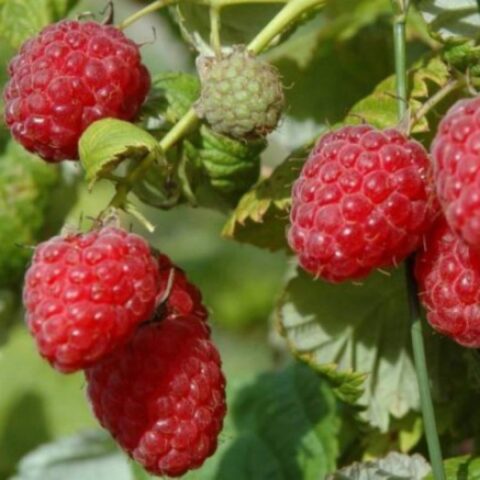
Velvet raspberry is especially resistant to gray rot
Tourmaline
The large-fruited variety Tourmaline produces large pink-red berries with good density. It has a sweet and sour taste and usually ripens by the end of July or the beginning of August. The weight of individual berries is about 5 g, and up to 3 kg of juicy drupes can be collected from a bush.

Tourmaline raspberries are pest resistant but may suffer from purple spot
Gift of Siberia
Raspberry Gift of Siberia bears soft cream-colored sweet fruits with a pleasant aroma. Recommended for the Urals and the Far East, grows up to 2.8 m, practically does not form root shoots. The berries of the variety are small, up to 2 g in weight. They do not fall off after ripening; the purpose of the fruit is dessert.
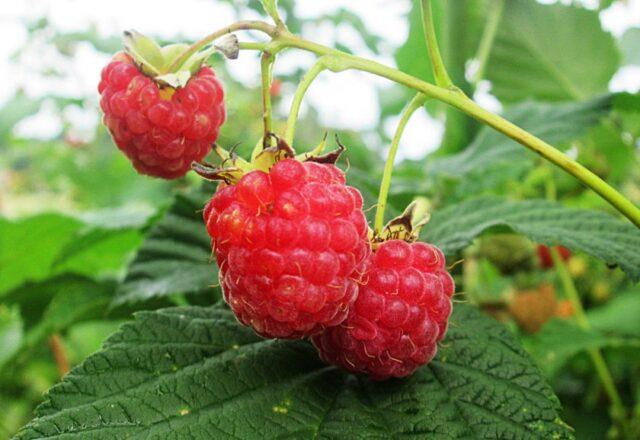
You can harvest Dar of Siberia raspberries at 4.5 kg per bush from the beginning of August
Late varieties
For the Urals, late raspberry varieties are worse suited than early and middle ones. However, some varieties can still be grown in harsh climates, although yields may be unstable.
August miracle
The remontant raspberry variety produces large berries up to 8 g from mid-August until the first frost. The fruits are sweet, juicy, universal purpose, suitable for subsequent sale. Under favorable conditions in the Urals, one raspberry bush can produce up to 5 kg of berries.
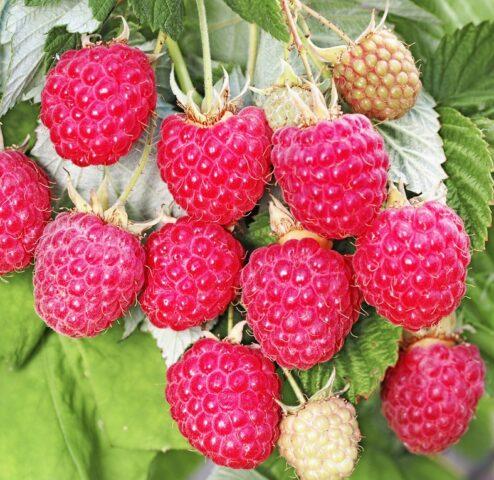
Raspberry August miracle requires garter to the trellis
Diamond
The raspberry variety bears fruit from late summer until the first frost and produces red berries that are slightly pointed at the bottom and weigh about 7 g. It has a good sweet taste and high pulp density. It is recommended to plant the plant in the sun, since in the shade the berries remain small and do not acquire dessert qualities.

The yield of raspberries of the Diamond variety is high - about 5 kg per bush
Bryansk miracle
A tall, remontant variety up to 2 m above the ground forms up to nine fruiting shoots.Brings elongated bright red berries up to 11 g in weight with a sour-sweet taste. Well suited for the Urals, not afraid of severe winter frosts. Fruiting begins in mid-August and continues until the first snow.

The Bryansk miracle raspberry is characterized by the formation of berries along the entire length of the shoots from the base to the top
Conclusion
The best varieties of remontant raspberries for the Urals are characterized by increased cold resistance. It is recommended to choose varieties with early fruiting, which completely stops until mid-autumn.
Reviews of raspberry varieties for the Urals








